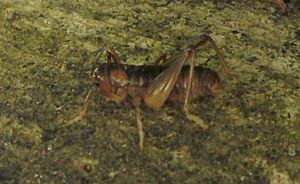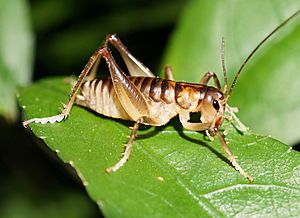Hemiandrus pallitarsis facts for kids
Quick facts for kids Hemiandrus pallitarsis |
|
|---|---|
 |
|
| Scientific classification | |
| Kingdom: | |
| Phylum: | |
| Class: | |
| Order: | |
| Family: |
Anostostomatidae
|
| Genus: |
Hemiandrus
|
| Species: |
H. pallitarsis
|
| Binomial name | |
| Hemiandrus pallitarsis (Walker, 1869)
|
|
| Synonyms | |
|
|
Hemiandrus pallitarsis is a type of ground weta that lives only in New Zealand. These insects are active at night (this is called nocturnal). During the day, they hide in burrows underground. They are an important food source for kiwi birds.
You can tell them apart by special features on their legs. They also hear through vibrations in the ground, not with ear-like organs. Female H. pallitarsis have a unique part on their abdomen. Males have dark hooks on their last body segment. These weta live for about two years. What they eat is mostly a mystery! What's really cool is that the female weta takes care of her eggs and young, which is unusual for an insect.
Contents
How Hemiandrus pallitarsis Got Its Name
Hemiandrus pallitarsis was first described by a scientist named Francis Walker in 1871. He first put it in a different group called Libanasa. Later, in 1906, another scientist, W. F. Kirby, moved it to the group Ceuthophilus.
Then, in 1938, Kjell Ander created the group Hemiandrus. He moved this weta species into it. So, the names Libanasa pallitarsis Walker and Hemiandrus furcifer Ander are older names for the same species. They are called synonyms.
Where They Live
Hemiandrus pallitarsis weta are found only on the North Island of New Zealand. They are very common and live in many places across this island.
During the day, they hide in burrows in the ground because they are nocturnal. At night, they become very active. You can find them moving around on the ground. They also climb on plants like beech trees, kanuka bushes, and the leaves of plants like kawakawa. These weta usually live in areas that are less than 200 meters above sea level.
Conservation Status
The New Zealand Department of Conservation looked at this species in 2014. They decided that Hemiandrus pallitarsis is "not threatened." This means there are plenty of them, and they are not in danger of disappearing. Because they are widespread and common, they are considered a species of least concern.
Since these weta are active at night, they are an important food source for kiwi birds in areas where kiwi live.
What They Eat
Scientists don't fully know what Hemiandrus pallitarsis eats. Other types of Hemiandrus weta eat different things. Some are carnivores (meat-eaters), some are omnivores (eating both plants and animals like fruit, other small creatures, and seeds), and some are herbivores (plant-eaters, like apricots and grasses).
In the summer, in the Orongorongo forest on the southern North Island, these weta are often seen climbing tree trunks. Many climb into hard beech trees. At the same time of year, moth caterpillars that feed on hard beech trees are very common. This might explain why the weta climb these trees.
Body Features
Hemiandrus pallitarsis has specific body features that help scientists identify them. They have a single spine on their front legs. Their middle legs have three spines on one side and four on the other.
Male weta have dark hooks on their last body segment. Adult females have a unique, elbow-like, forked part on their abdomen. This special part is found only on this species of Hemiandrus. Females also have a very short ovipositor, which is the tube they use to lay eggs. It's so short that sometimes people might mistake females for males!
Unlike many other insects, H. pallitarsis does not have tympanal membranes (ear-like organs) on their legs. Instead, they can detect sound through their hard outer skin, called the cuticle. This ability to feel vibrations through the ground is very helpful for their underground life.
Reproduction and Life Cycle
Hemiandrus pallitarsis adults come out of their burrows at night. They often sit on top of leaves, like those of the kawakawa plant. They use special chemicals called pheromones and make drumming sounds to attract mates. Most mating happens on top of these leaves. The drumming sound is made by tapping their abdomen on a surface, like a plant leaf.
The female's special abdomen part is thought to help her get "nuptial gifts" from the male. These gifts are full of nutrients, which help the female lay more eggs. The bigger this special part is, the larger the gift the male gives. This means females with larger abdomen parts can lay more eggs. This suggests that males choose females with larger appendages, as it means the female is healthier and can have more babies.
Females dig small "brood chambers" (up to 2.5 centimeters deep) underground to lay their eggs. They stay with their eggs until they hatch, often until the female dies. A female lays about 50 eggs at a time. Her short ovipositor helps her lay eggs inside the chamber, instead of directly into the soil like some other weta.
H. pallitarsis shows maternal care, which is very rare for Orthopterans (the group that includes weta, grasshoppers, and crickets). The mother weta continuously cares for her clutch of eggs. She covers them with soil and even moves them if the burrow starts to flood. She also physically and aggressively defends her eggs. Other species in the Hemiandrus group also show maternal care, but only those with short ovipositors.
Eggs are usually laid in July (winter in New Zealand). They hatch in September and October (spring). Young weta are most often seen between December and March. Adult weta can be found throughout the year. Young weta likely take up to a year to grow into adults. Once they are adults, they live for about two years.
Images for kids




